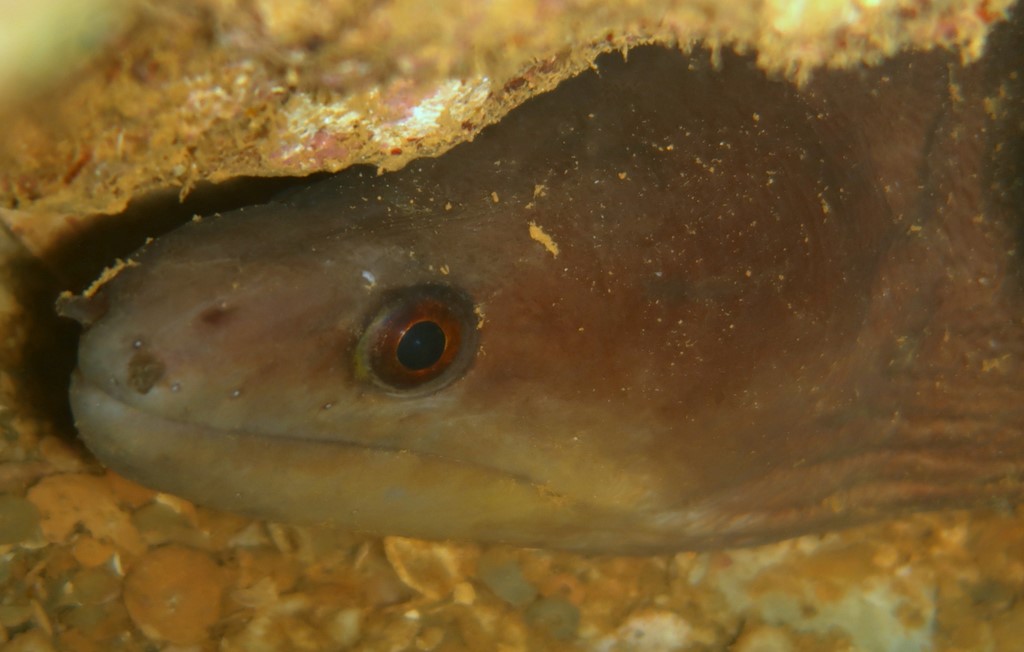GYMNOTHORAX MONOCHROUS - (BLEEKER, 1856)
Picture courtesy of: Alain Daoulas
Actinopterygii (Gigaclass) > Actinopteri (Class) > Teleostei (Subclass) > Elopomorpha (Superorder) > Anguilliformes (Order) > Muraenoidei (Suborder) > Muraenidae (Family) > Muraeninae (Subfamily) > Gymnothorax (Genus)
Murène monotone, Monotone moray, Brown moray, Drab moray, Drab moray eel, Monochrome moray, Plain moray eel, Moreia pardenta, Yami-utsubo, ヤミウツボ, 黃紋裸胸鱔,
Synonyme
Muraena monochrous (Bleeker, 1856)
------------------------
Description
Predorsal vertebrae: 4-6, preanal: 56-61, total: 136-143; Body depth at gill opening: 14-21 in TL; Body depth at anus: 15-25. Head length: 7.7-9.4 in TL; Origin of dorsal fin midway between corner of mouth and gill opening; Anus anterior to middle of body; Preanal length: 2.0-2.5 (usually: 2.1) in TL; Snout length: 5.0-5.9 in HL, upper jaw: 2.2-2.7 in HL, and eye diameter: 9.0-11.0 in HL. Teeth long, many long fangs; Intermaxillary teeth in 3 rows, with 3 long median fangs; Teeth on both jaws biserial anteriorly; Vomerine teeth uniserial. Max. length: 80.0 cm TL. Depth range: 1 - 41 m, usually: 1 - 20 m.
Color
A uniformly tan to brown moray, sometimes becoming paler below, with no contrasting markings.
Etymology
Gymnothorax: from Greek, gymnos = naked + from Greek, thorax, -akos = breast. The genus was created in 1795 by Bloch who indicated: "The fishes of this genus are recognized by the fact that they have no pectoral fins". This characteristic is one of the main marks of the genus, allowing to distinguish it from the eels in which Linnaeus classified the moray eels. The name of the genus thus refers explicitly to the absence of pectoral fins = chest without fins.
monochrous: from Greek prefix, mónos = one, single, only + from Greek, chroa, chroia = skin. Referring to its bronze-brown color without spots or bands.
Original description: Muraena monochrous Bleeker, 1856- Type locality: Ternate, Molucca Islands, Indonesia.
Distribution
Indo-West Pacific: East Africa, Madagascar and Rodrigues, east to Indonesia and Papua New Guinea, north to Taiwan, south to Western Australia and New Caledonia.
Biology
Inhabits relatively turbid areas of sheltered lagoon reefs. Including mangroves.
Similar species
Gymnothorax atolli (Pietschmann, 1935) - Reported from Red Sea, western Pacific: southern Japan, Lord Howe Island, Hawaiian Islands Chain (Pearl and Hermes Reefs to Midway Atoll).
Gymnothorax moluccensis (Bleeker, 1864) - Reported from Red Sea; Indo-West Pacific: KwaZulu-Natal (South Africa), Christmas Island, Indonesia and Coral Sea.
Gymnothorax pindae (Smith, 1962) - Reported from New Caledonia. Differs from Gymnothorax monochrous by having lower jaw teeth that are finely serrated on their posterior margins.
Last update: 1, April 2024
Actinopterygii (Gigaclass) > Actinopteri (Class) > Teleostei (Subclass) > Elopomorpha (Superorder) > Anguilliformes (Order) > Muraenoidei (Suborder) > Muraenidae (Family) > Muraeninae (Subfamily) > Gymnothorax (Genus)
Murène monotone, Monotone moray, Brown moray, Drab moray, Drab moray eel, Monochrome moray, Plain moray eel, Moreia pardenta, Yami-utsubo, ヤミウツボ, 黃紋裸胸鱔,
Synonyme
Muraena monochrous (Bleeker, 1856)
------------------------
Description
Predorsal vertebrae: 4-6, preanal: 56-61, total: 136-143; Body depth at gill opening: 14-21 in TL; Body depth at anus: 15-25. Head length: 7.7-9.4 in TL; Origin of dorsal fin midway between corner of mouth and gill opening; Anus anterior to middle of body; Preanal length: 2.0-2.5 (usually: 2.1) in TL; Snout length: 5.0-5.9 in HL, upper jaw: 2.2-2.7 in HL, and eye diameter: 9.0-11.0 in HL. Teeth long, many long fangs; Intermaxillary teeth in 3 rows, with 3 long median fangs; Teeth on both jaws biserial anteriorly; Vomerine teeth uniserial. Max. length: 80.0 cm TL. Depth range: 1 - 41 m, usually: 1 - 20 m.
Color
A uniformly tan to brown moray, sometimes becoming paler below, with no contrasting markings.
Etymology
Gymnothorax: from Greek, gymnos = naked + from Greek, thorax, -akos = breast. The genus was created in 1795 by Bloch who indicated: "The fishes of this genus are recognized by the fact that they have no pectoral fins". This characteristic is one of the main marks of the genus, allowing to distinguish it from the eels in which Linnaeus classified the moray eels. The name of the genus thus refers explicitly to the absence of pectoral fins = chest without fins.
monochrous: from Greek prefix, mónos = one, single, only + from Greek, chroa, chroia = skin. Referring to its bronze-brown color without spots or bands.
Original description: Muraena monochrous Bleeker, 1856- Type locality: Ternate, Molucca Islands, Indonesia.
Distribution
Indo-West Pacific: East Africa, Madagascar and Rodrigues, east to Indonesia and Papua New Guinea, north to Taiwan, south to Western Australia and New Caledonia.
Biology
Inhabits relatively turbid areas of sheltered lagoon reefs. Including mangroves.
Similar species
Gymnothorax atolli (Pietschmann, 1935) - Reported from Red Sea, western Pacific: southern Japan, Lord Howe Island, Hawaiian Islands Chain (Pearl and Hermes Reefs to Midway Atoll).
Gymnothorax moluccensis (Bleeker, 1864) - Reported from Red Sea; Indo-West Pacific: KwaZulu-Natal (South Africa), Christmas Island, Indonesia and Coral Sea.
Gymnothorax pindae (Smith, 1962) - Reported from New Caledonia. Differs from Gymnothorax monochrous by having lower jaw teeth that are finely serrated on their posterior margins.
Last update: 1, April 2024
